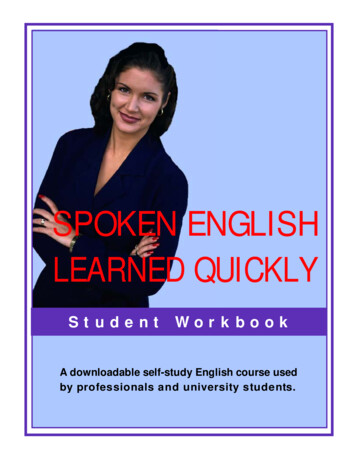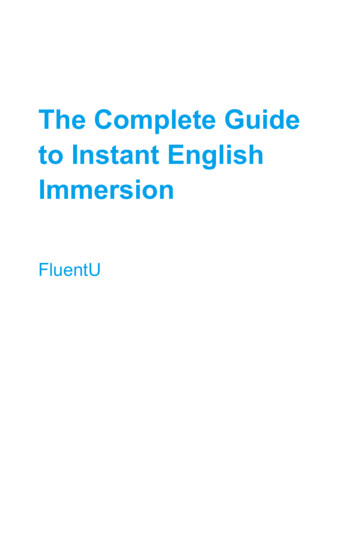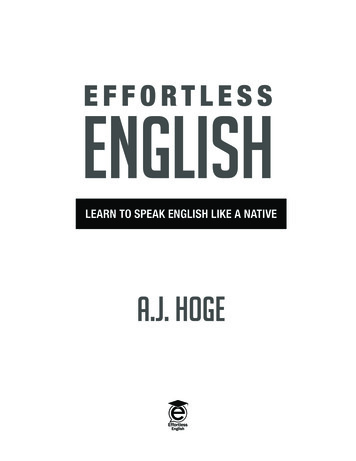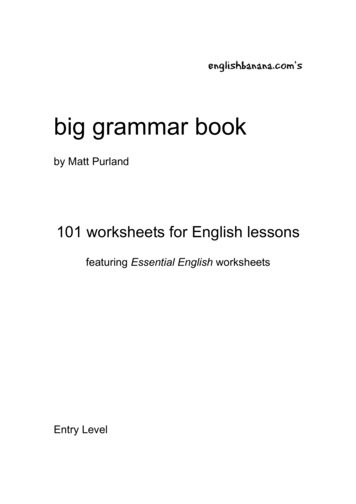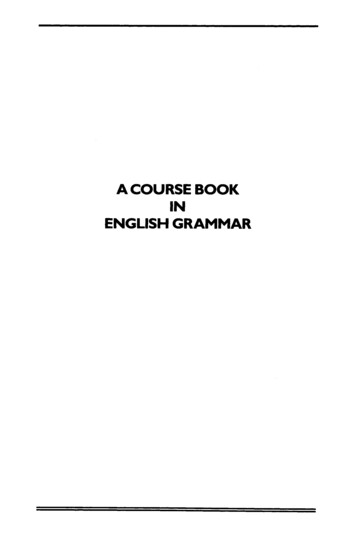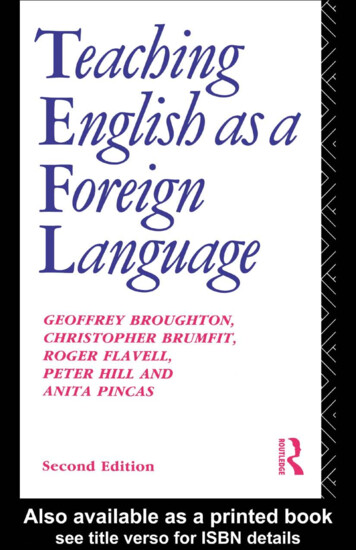
Transcription
KERALA READERENGLISHPART - 2Standard IXGovernment of KeralaDEPARTMENT OF EDUCATIONPrepared byState Council of Educational Research and Training (SCERT)KERALA2010
THE NATIONAL ANTHEMJana-gana-mana adhinayaka, jaya angaUchchala-Jaladhi-tarangaTava subha name jage,Tava subha asisa mage,Gahe tava jaya gatha.Jana-gana-mangala-dayaka jaya heBharatha-bhagya-vidhata.Jaya he, jaya he, jaya he,Jaya jaya jaya, jaya he!PLEDGEIndia is my country. All Indians are my brothers and sisters.I love my country, and I am proud of its rich and varied heritage.I shall always strive to be worthy of it.I shall give respect to my parents, teachers and all elders andtreat everyone with courtesy.I pledge my devotion to my country and my people. In theirwell-being and prosperity alone lies my happiness.Prepared by:State Council of Educational Research and Training (SCERT)Poojappura, Thiruvananthapuram -12, Kerala.Website: www.scertkerala.gov.ine-mail: scertkerala@asianetindia.comPhone : 0471-2341883, Fax : 0471-2341869First Edition : 2010Type setting : SCERT Computer Lab Government of KeralaDepartment of Education2010
Dear studentsThe English Reader (Part 1 & Part 2) for Standard IX hasbeen designed with a view to developing your proficiencyin English language. The learning of any language inevitablyinvolves the learning of its rich and varied literature. Englishas an international language is no longer a singlehomogeneous entity. There are numerous 'Englishes'originating from different social and national communities.You will surely find an opportunity to experience how socialsituations influence the making of language. The selectionsin this book represent authors from different culturesranging from Coleridge to Kamala Das and Pushkin toSinger. It also brings in a variety of literary genres likepoetry, short story, one act play, article and memoir.You can enjoy reading the texts and think creatively onceyou enter the world of letters that the authors create for you.I hope you will make use of this book to sharpen yourEnglish language skills. The variety of activities presentedin the book, I am sure, will provide ample opportunitiesfor you to use the language in different contexts. Yourteacher will guide you through your efforts while interactingwith the texts and activities in the book.Learn to use English confidently and find out howinteresting it is.Wish you all success.Prof. M.A. KHADERDirectorSCERT
Textbook Development CommitteeEnglishAdvisorStandard IXProf. K.A. Jayaseelan, Professor Emeritus, English and Foreign LanguagesUniversity, HyderabadChairpersonProf. (Dr) Jameela Begum A. Professor, Institute of English & Director,Centre for Canadian Studies, University of KeralaSpecial InviteeNasiruddin Khan, Formerly of Dept. of Languages, NCERT, New DelhiMembersS.V. Bindu, HSST, Janardhanapuram HSS Ottasekharamangalam, ThiruvananthapuramK.K. Chandini, Assistant Professor, SCERTK. Chandran, HSST, Govt. HSS, Vadakara, KozhikodeK.T. Dinesh, Research Officer, SCERTJalson Jacob, Lecturer, Govt. Polytechnic College, KottayamK. Jayarajan, HSA, Perambra HS, KozhikodeJose D’ Sujeev, HSA, GVHSS Karakulam, ThiruvananthapuramJose K. Philip, Lecturer, Govt. Polytechnic College, Vechoochira, PathanamthittaMuhammed Shiyas, HSST, GHSS Beypore, KozhikodeP.V. Preetha, NVT, GVHSS Manacaud, ThiruvananthapuramK.V. Raveendran, HSA, GVHSS Madikkai II, KasargodeReshmi Reghunath, HSST, GVHSS, Karakulam, ThiruvananthapuramK.V. Sajai, HSST, GMHSS Muvattupuzha, ErnakulamS. Sujith, HSA, Pantheerankavu HS, KozhikodeDr N. Suresh Kumar, Research Officer, SCERTAcademic Co-ordinatorS. Raveendran Nair, Assistant Professor, SCERTArtistP. Ramesan, Drawing Teacher, Iringannoor HSS, KozhikodeExpertsDr Cherian John, Lecturer, Mar Ivanios College, ThiruvananthapuramDr B. Hariharan, Lecturer, Institute of English, University of KeralaDr B.S. Jamuna, Director, CELT, Institute of English, University of KeralaDr C.A. Lal, Selection Grade Lecturer, Christian College, Kattakada, ThiruvananthapuramDr Saji Mathew, Lecturer, School of Letters, Mahatma Gandhi University, KottayamProf. V.K. Saraswathy, Professor (Rtd), Govt. Women’s College, ThiruvananthapuramProf. S. Sasikumaran Unnithan, Professor (Rtd), Govt. Arts College, ThiruvananthapuramDr K.M. Sherrif, Reader, Department of English, University of Calicut
ContentsUnitsUnit - IV Glimpses of a Green PlanetPages107-131Make the Right Choice (Editorial)109To Nature (Poem)119Memories of a Dying River (Article)122On the Grasshopper and Cricket (Poem )126Unit - V Guns and RosesAn Occurrence at Owl Creek Bridge(Short Story)General, Your Tank is a Powerful Vehicle(Poem)132-155133144The Colonel’s Ideas (Short Story)146Mass (Poem)151Unit - VI Mirroring the Times156-176The Mass Media (Article)157Television (Poem)164The Initial Days of Doordarshan (Article) 167Glossary177-184
CONSTITUTION OF INDIAPart IV AFUNDAMENTAL DUTIES OF CITIZENSARTICLE 51 AFundamental Duties- It shall be the duty of every citizen of India:(a) to abide by the Constitution and respect its ideals and Institutions, the NationalFlag and the National Anthem;(b) to cherish and follow the noble ideals which inspired our national struggle forfreedom;(c) to uphold and protect the sovereignty, unity and integrity of India;(d) to defend the country and render national service when called upon to do so;(e) to promote harmony and the spirit of common brotherhood amongst all thepeople of India transcending religious, linguistic and regional or sectionaldiversities; to renounce practice derogatory to the dignity of women;(f)to value and preserve the rich heritage of our composite culture;(g) to protect and improve the natural environment including forests, lakes, rivers,wildlife and to have compassion for living creatures;(h) to develop the scientific temper, humanism and the spirit of inquiry and reform;(i)to safeguard public property and to abjure violence;(j)to strive towards excellence in all spheres of individual and collective activityso that the nation constantly rises to higher levels of endeavour and achievements.(k) who is a parent or guardian to provide opportunities for education to his child or,as the case may be, ward between age of six and fourteen years.
UNIT IVGLIMPSES OF A GREEN PLANETEnglish 0123107
CARTOONCARTDiscussWhere does the flood as shown in the cartoon occur?What do you think is the cause of the flood?What clues are there to identify the season portrayed?Does the cartoon warn us of any impending danger?English 0123108
MAKE THE RIGHT CHOICEEDITORIALEDITORIALMAKE THE RIGHT CHOICEThe print media stand united to speak about a current issue that affectsthe whole world. Read and find out.1. To which issue has theworld's response been 'feebleand half-hearted'? (Para-1)Monday, December 7, 2009Today 56 newspapers in 45 countries take theunprecedented step of speaking with one voice througha common editorial. We do so because humanity faces aprofound emergency. Unless we combine to take decisiveaction, climate change will ravage our planet and withit our prosperity and security. The dangers are apparentfor our generation. Now the facts have started to speak:the Arctic ice-cap is melting and last year’s inflamed oiland food prices provide a foretaste of future havoc. Inscientific journals the question is no longer whetherhumans are to blame, but how little time we have gotleft to limit the damage. So far, the world’s response hasbeen feeble and half-hearted.1.We call on the representatives of the 192 countriesgathered in Copenhagen not to hesitate, not to fall intodispute, not to blame each other but to seize opportunityfrom the greatest modern failure of politics. This should2.2. Do you think the CopenhagenSummit was effective inresolving the crisis of globalwarming? If so, why?(Para-2)KEEP TRACK OF YOUR READINGAs you read you can use thefollowing marks to keep trackof your understanding.9 . I understand this.?. I don't understand this.!. Interesting/ surprising ideaEnglish 0123109
MAKE THE RIGHT CHOICEnot be a fight between the rich world and the poor world,or between east and west. Climate change affectseveryone and must be solved by everyone. The science iscomplex but the facts are clear. The world needs to takesteps to limit temperature rise. Even a small increasewould parch continents, turning farmland into desert.Half of all species could become extinct, untold millionsof people would be displaced, whole nations drownedby the sea.We will have to change our lifestyles. The era of flightsthat cost less than the taxi ride to the airport is drawingto a close. We will have to shop, eat and travel moreintelligently. We will have to pay more for our energyand use less of it. But the shift to a low-carbon societyholds out the prospect of more opportunity thansacrifice. We have now started to invest in renewableforms of energy rather than producing electricity fromfossil fuels. Kicking our carbon habit within a few shortdecades will require a feat of engineering andinnovation to match anything in our history. But whereasputting a man on the moon or splitting the atom wereborn of conflict and competition, the coming carbon racemust be driven by a collaborative effort to achievecollective salvation.3.Overcoming climate change will take a triumph ofoptimism over pessimism, of vision overshortsightedness. It is in that spirit that 56 newspapersfrom around the world have united behind this editorial.If we, with such different national and politicalperspectives, can agree on what must be done, thensurely our leaders can too. The politicians in Copenhagenhave the power to shape history’s judgment on thisgeneration: one that saw a challenge and rose to it, orone so stupid that saw calamity coming but did nothingto avert it. We implore them to make the right choice.4.Adapted from 'The Hindu' - December 7, 2009After reading a section,write down the word youwould like to add to yourpersonal wordlist.Word: .Meaning: .Sentence: .3.What do you understand by'shopping, eating and travellingmore intelligently'? (Para-3)4.What is 'collective salvation'and how can it be achieved?(Para-3)ASSESS YYOUROURSELFASSESSOURSELFREADINGHave I read the passage on myown and marked what Iunderstood with a '9'?Have I marked words/expressions that I didn'tunderstand with a '?'?Have I picked out words/expressions for my personalwordlist?Have I shared the ideas Igathered with my friends duringthe group reading process?Have I tried to get clarificationfor the words/ expressions Ididn't understand?Have I been able to answer thequestions posed by theteacher?What improvement should Imake in my reading?English 0123110
READY REFERENCEavert /?!u29s/(v): to prevent something bad or dangerous fromhappening5. When was the editorialwritten, before or after thesummit? Give reasons for youranswer. (Para-4)calamity (n): a terrible and unexpected event that causes a lot ofdamage and sufferingcollaborate/j?!kza?qdHs/(adj): work togetherdecisive /cH!r HrHu/(adj): having great effect on the way thatsomething developsdispute (n): an argument between two persons, institutions,countries etc.extinct/Hj!rsHMjs/(adj): something that exists no moreforetaste(n): a sign of something more important or more impressivethat will happen in the futurehavoc/!gzu?j/(n): a situation in which there is a lot of damage,destruction or disorderinflamed(adj): heightened or raisedperspective/o?!rodjsHu/(n): a way of thinking about something;viewpointprofound/oq?!e Tmc/(adj): having a strong influence or effect; deeprenewable energy(adj): energy that replaces itself naturally or iseasily replaced because there is a large supply of itsalvation /rzk!udHR?m/(n): the state of being saved from danger,salvaloss, disaster etc.seize(v): to grab or hold somethingunprecedented /Um!oqdrHc?msHc/(adj): something that has neverhappened, been done or been known beforeAfter reading a section,write down the word youwould like to add to yourpersonal wordlist.Word: .Meaning: .Sentence: .English 0123111
TEXTUAL ACTIVITIETEXTUALTIVITIESSActivity 1Let's analyse the editorial.a) How does the editorial begin? Is such a beginning common for editorialsin dailies? If not, why? How many sentences are there in the text explainingthe reason for the special editorial?b) What is the editorial about? Which are the sentences that give youclear clues? Pick out the sentences. Which one would you call the topicsentence of the editorial?c) What is the first paragraph about? Are there references to the effectsof climate change? Quote relevant sentences.d) What does the second paragraph deal with? Does it have a persuasivetone? Support your answer by listing words/phrases from the paragraphshowing persuasion. Pick out the sentences describing the ill-effects ofclimate change in paragraph 2.English 0123112
TEXTUAL ACTIVITIETEXTUALACTIVITIESSe) In paragraph 3, a common subject is used for many sentences. Whatis it? What does the editorial focus on in this paragraph? Is there a sarcasticstatement towards the end of the paragraph? Quote the sentence.f) Paragraph 4 is about certain opposites and the need to choose onefrom each pair. What are they? Does the paragraph also provide a modelfor the politicians to follow? What is that model? How is the editorialconcluded?English 0123113
TEXTUAL ACTIVITIETEXTUALACTIVITIESSActivity 2Given below is a letter to the editor commenting on the editorial you havejust read.The EditorThe HinduKochiSirit or ia l ones se d by yo ur edprimypleedamIthe majorlimate change isC.09207,rbeDecemssions and debatescuisDy.datocefalmenace we alI am oft nothing happens.Bu.onearcpitoon theiltion based on fossranegeityictrecelthe view thatl carbonributor to harmfuntcoorajmethfuel isre cl am ou ri ng foarhowlepeoPem is si on .p ow err an in cr ea se infollcatenmopd ev elbemma that has tolediethisisThgeneration.: we cano possible solutionstwvehaeWe.movercotonsumption or turncoityictrecelceeither reduectricityergy. We misuse elenofsceursoleabrenewaya National Highwe,oralngBainegrossly. Herroughoutort is brightly lit thrpaiwneethtogleadininabout 30 km. Evenofceanstdiaerthe night ovd humid,er is not very hot antheawethrehewplacesan dit io ne d ho u se sndcoraiinpm an y sl eeise enoughtime we became wghhiisIt.tsentmaparumption.about energy consAfter reading a section,write down the word youwould like to add to yourpersonal wordlist.Word: .Meaning: .AnupamBangalore09/12/2009.Sentence: .English 0123114
TEXTUAL ACTIVITIETEXTUALACTIVITIESSThe editorial you have analysed states that we will have to change ourlifestyles and we will have to shop, eat and travel more intelligently. Doyou agree? Prepare a letter to the editor expressing your views.ASSESS YYOUROURSELFASSESSOURSELFLETTERHave I written a personal letter/letter to the editor?Have I used appropriatelanguage in the letter?Have I kept the appropriateformat of the letter?Have I been able to convey theideas I wanted to express?How well have I participated ingroup refinement?How can I improve writing aletter next time?Activity 3Global warming poses a serious threat to our planet. Prepare five sloganshighlighting the need for protecting the earth from global warming.SLOGANHave I been able to form clearideas about the aspects of thetopic to be highlighted in theslogan ?Have I been able to use crispand catchy sentences toexpress the idea?How well have I conveyed themessage?How far have I activelycontributedtogrouprefinement?Activity 4How should I improve next timewhen I write a slogan?You may have noticed instances of climate change in your surroundings.Mention a few of them.e.g. severe coldNow, read the article 'Memories of a Dying River' by M.T.Vasudevan Nairgiven in the Extended Reading section of this unit on Page 122.English 0123115
VOCABULARY ACTIVITIESActivity 1In the first paragraph of the editorial, we come across the word 'foretaste'. There are a few more wordsprefixed with fore- in English.Refer to a dictionary and add more words to the list given below. Also find out what they mean. foretell forecast Activity 2The word 'renewable' used in the editorial is a combination of the prefix 're-' and the suffix '-able' to theroot word new.Fill up the table given below with prefixes and suffixes from the words given.empowerment, unforgettable, rethinkable, envisioning, reusable, disconnected, unbearable,discontinuous, unrecognisableprefixrootsuffixActivity 3In the third paragraph we come across the phrase 'kicking our carbon habit'. The phrase 'kick the habit'means 'to stop doing something that is harmful'. Other idioms with the word 'kick' are listed below. Withthe help of a dictionary find out what they mean.(i) kick around -(ii) kick up a fuss -(iii) kick up your heels -(iv) kick off -(v) kick somebody around -Now, use them in sentences of your own.English 0123116
VOCABULARY ACTIVITIESActivity 4The word 'feat' in the third paragraph of the editorial sounds like 'feet'. 'Feat' means 'an action that needscourage and skill' whereas 'feet' is the plural of foot, which means 'the bottom part of the leg that youstand on and walk'. Words that sound the same as another but different in spelling, meaning and originare called homophones.Collect at least five such pairs and use them in sentences of your own.eg: see-seaI can't see anything in the dark.The sea is quite rough today.1.2.3.4.5.Activity 5The editorial ends with the statement, 'We implore them to make the right choice.'Substitute 'implore' with words similar in meaning. plead Activity 6The editorial talks of 'a triumph of optimism over pessimism'. 'Pessimism' is the antonym of 'optimism'.Frame sentences with antonyms of the words in bold italics:e.g. He looks feeble.He is strong enough to lift the heavy box.English 0123117
VOCABULARY ACTIVITIES1. The process is complex.2. We can agree on what must be done.3. The whole world has been united behind this editorial.4. We must take decisive action.Activity 7Pick out sentences from the editorial in which the following phrases have been used. Use them in yourown sentences.a) with one voice:b) take steps to:c) draw to a close:d) to shape (something):e) make the right choice:English 0123118
TO NATURENATUREPOETRYTO NATURENATUREYou have seen the unfriendly attitude of humans towards Mother Earth.But poets have always found comfort in the lap of Nature. See what thepoem says.Samuel Taylor Coleridge(1772 -1834) is an Englishpoet, literary critic andphilosopher. He and his friendWordsworth are regarded asthe founders of the RomanticMovementinEnglishLiterature. He is best knownfor his poems 'The Rime of theAncient Mariner' and 'KublaKhan'. His major prose workis 'Biographia Literaria'.1.What does the phrase 'allcreated things' bring to yourmind?2. Pick out the expressionsthat show the intense andpersonal experience of thepoet.It may indeed be phantasy, when IEssay to draw from all created things3. Is the experience of the poetmere phantasy? If yes, why?Deep, heartfelt, inward joy that closely clings;And trace in leaves and flowers that round me lieLessons of love and earnest piety.4. In what way can natureteach us lessons of real joy?So let it be; and if the wide world ringsIn mock of this belief, it bringsNor fear, nor grief, nor vain perplexity.English 0123119
TO NATURENATURETEXTUAL ACTIVITIETEXTUALACTIVITIESSSo will I build my altar in the fields,5.What does the expression'let it be' suggest?And the blue sky my fretted dome shall be,And the sweet fragrance that the wild flower yieldsShall be the incense I will yield to Thee,Thee only God! and thou shalt not despiseEven me, the priest of this poor sacrifice.6. Some people may ridiculethe poet's ideas, but he is notworried or afraid. Pick out thelines that mean the same.SAMUEL TAYLOR COLERIDGEYLORTEXTUAL ACTIVITIETEXTUALACTIVITIETIVITIESSActivity 1Look at the following lines from Shakespeare's 'The Tempest'.7. What is the offering the poetis going to make?Full fathom five thy father lies;Of his bones are coral made;Those are pearls that were his eyes.Notice the same sound being repeated at the beginning of the words inthe first line. This lends a musical quality to the line. The repetition of the8. Why does the poet say thathis offering is 'poor'?same sound in this manner is called alliteration.Pick out two instances of alliteration from the poem.Activity 29. What is common betweenthe poet and a priest in thispoem?What is striking about the following lines?The small birds twitter,The lake doth glitter,The lines end with the same combination of sounds, don't they? Words ina poem ending with the same sound are called rhyming words. In theabove lines 'twitter' rhymes with 'glitter'.Pick out some pairs of rhyming words from the poem.English 0123120
TEXTUAL ACTIVITIETEXTUALACTIVITIESSActivity 3Identify the olfactory and visual images used by the poet in the last sixlines of the poem and describe them in your own words.Activity 4Read the following lines from Shakespeare's 'As You Like It'.All the world's a stage,And all the men and women merely players:In these lines the world is regarded as a stage with people performingdifferent roles. Here 'stage' acts as a metaphor for 'world'.Pick out a few metaphors in the poem.Activity 5Which lines in the poem do you find most appealing from the followingASSESS YYOUROURSELFASSESSOURSELFAPPRECIATIONangles:Have I begun in a strikingmanner?i. beautiful words arranged beautifullyHave I been able to quote linesto support my views?ii. meaning or ideas suggested by the lineAlso read aloud the lines and try to recall lines from other poems suggestingsimilar ideas/ meaning.Have I been able to organisemy writing into cohesiveparagraphs?How well have I been able toconnect the sentences I havewritten?Have I been able to suggestnew ideas in my writing?What changes will I make nexttime I prepare an appreciation?Now, read the poem 'On the Grasshopper and the Cricket' by John Keatsgiven in the Extended Reading section of this unit on Page 126.English 0123121
MEMORIES OF A DYING RIVEREXTENDED READING - ARTICLEMEMORIES OF A DYING RIVEROur lifestyle is taking tolls on all natural resources. Here is a descriptionof how we are responsible for the sufferings of a river.Standing proudly on the newly constructed bridge acrossthe Bharathapuzha in 1954, Edasseri, the renownedpoet, who had blazed a new trail in Malayalam poetry,gazed and gazed at the emaciated river beneath. Itbecame the subject of his celebrated poem KuttippuramPaalam, a poem which has been quoted over and overagain in discussions on the eco-aesthetics of Malayalampoetry. The engineering skills that went into the makingof the bridge fascinated the poet. It cost a sum of twentythree lakh rupees to build it – a considerable sum at thetime. The poet saw in his mind’s eye the long lines ofvehicles, thousands of them, which would scamperacross the bridge into the distance. But he did not concealthe fear that lurked in his heart: the serenity of the villageswould vanish for ever. The poem ends on a note ofapprehension:Amba, Perare nee maarippomoAakulayaamorazhukku chaalaay?(O Perar, our beloved MotherWill you turn into a vexed drain?)But Bharathapuzha, popularly known as Nila or Perar,did not become a drain. The poet could not foresee thethreat of illegal sand mining on its shores and the desertlike state it was to be reduced to. Today the bed of theriver is dotted with mounds on which bushes grow.Between Kuttippuram and Thirunaavaaya, one can evensee tall casuarinas right in the middle of the dry river.The mounds are scarcily submerged, that too for a fewdays during the monsoon.M. T. Vasudevan Nair (b.1933),the noted writer andscreenwriter was born atKudallur, in Palakkad district.He has received many awardsincluding India's highestliterary award, the Jnanpith.His novels and stories capturethe agonies of people destinedto live in solitude. His majorworks include 'Nalukettu','Kaalam', 'Randaamoozham'etc.1. Poets in olden days used towrite about rivers, valleys,mountains and forests. ButEdasseri has written a poemabout a bridge too. Commenton this choice.2. What was the fear thatlurked in the poet's heart?After reading a section,write down the word youwould like to add to yourpersonal wordlist.Word: .Meaning: .Sentence: .
Artist P. Ramesan, Drawing Teacher, Iringannoor HSS, Kozhikode Experts Dr Cherian John, Lecturer, Mar Ivanios College, Thiruvananthapuram Dr B. Hariharan, Lecturer, Institute of English, University of Kerala . loss, disaster




